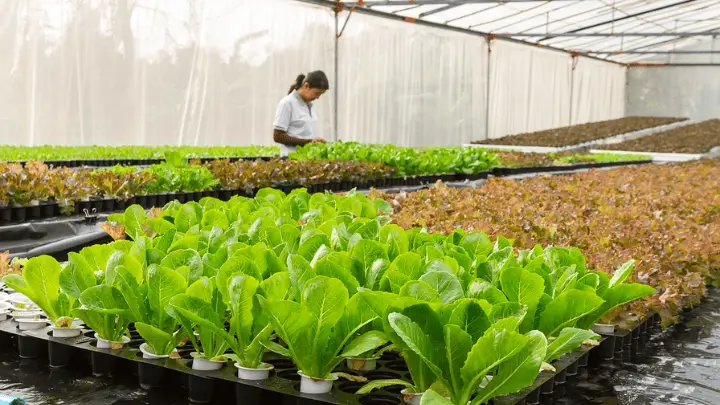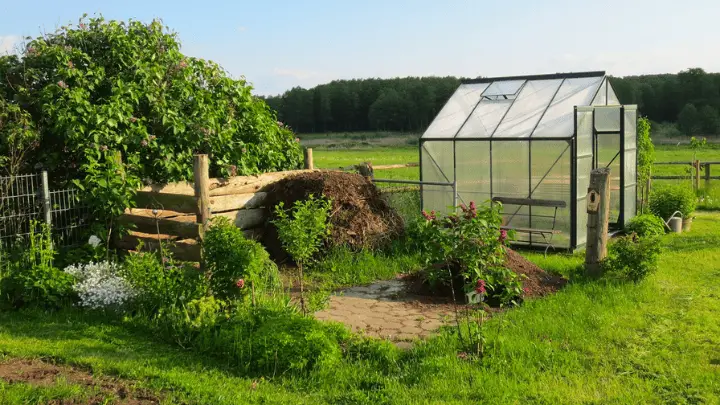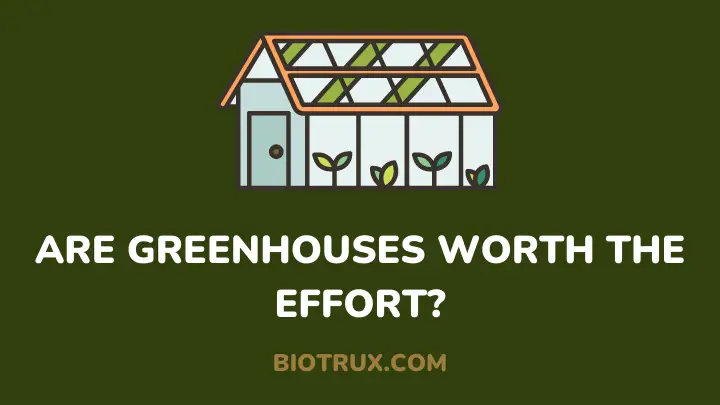Are you a gardening enthusiast always looking for ways to expand your growing capabilities? If so, then a greenhouse might be just the thing you need. But are greenhouses worth the effort? Let’s find out.
Greenhouses offer many benefits, including longer growing seasons, protection from pests and harsh weather conditions, and the ability to grow plants that wouldn’t typically thrive in your area. However, there are also cons, such as the cost and maintenance required.
In this article, you’ll discover the pros and cons of greenhouses, how they work, and some tips to get started with your greenhouse. By the end, you’ll better understand whether a greenhouse is worth the effort for your gardening needs.
So, let’s dive in and explore the exciting world of greenhouse gardening.
Overview of the Purpose and Benefits of Greenhouses
Greenhouses are structures designed to cultivate and protect plants. They serve various purposes, from extending growing seasons and increasing crop yields to protecting delicate plants from harsh weather conditions and pests.
Greenhouses also allow for controlled environments tailored to the specific needs of different types of plants. The benefits of greenhouses are numerous. They can help maximize space utilization and increase plant growth and production efficiency.
Greenhouses also provide opportunities for year-round cultivation and growing a wider range of plants in different climates. Whether you want to grow vegetables, flowers, or other plants, a greenhouse can provide the ideal environment to ensure your plants thrive.
How Does a Greenhouse Work?

Essentially, greenhouses trap sunlight and heat, creating a warm and humid environment perfect for growing plants. The walls and roof of a greenhouse are made of transparent materials like glass or polycarbonate, which allow sunlight to enter.
This light is then absorbed by the plants inside, providing them with the energy they need to grow. The warmth from the sun is also trapped inside the greenhouse, helping to create the perfect temperature for plant growth.
To maintain the ideal temperature, many greenhouses also have ventilation systems that allow fresh air to enter and exit. This helps to prevent overheating and keeps the air inside the greenhouse circulating, which is essential for the health of your plants.
In addition to sunlight and warmth, greenhouses require water and nutrients for plant growth. Many greenhouses have automated irrigation systems that provide a consistent water supply to plants.
They also often use a soilless growing medium like coco coir or rock wool, which can be enriched with nutrients to support plant growth.
Pros and Cons of Owning a Greenhouse
Pros
Owning a greenhouse is a dream come true for many garden enthusiasts. However, it is not all rainbows and sunshine. Here are some pros of owning a greenhouse.
1. Extended growing season: A greenhouse allows you to extend the growing season for your plants and veggies to enjoy fresh produce year-round.
2. Better environmental control: You can control the temperature, humidity, and light inside a greenhouse, providing your plants with the ideal growing conditions.
3. Protection from pests and diseases: A greenhouse can protect plants from pests and diseases common in outdoor gardens.
4. Aesthetic appeal: Greenhouses can add a charming touch to your garden, and you can customize them to match your style.
5. Hobby or business opportunity: Owning a greenhouse can be a hobby, but it can also be a profitable business opportunity if you choose to sell your produce.
Cons
1. Expensive: Greenhouses can be costly to purchase, install, and maintain.
2. Requires space: A greenhouse requires considerable space, so there may be other options for those with limited yard space.
3. Energy costs: Keeping a greenhouse warm in the winter can be costly, and using electricity to power lights can add to the energy bill.
4. Maintenance: Greenhouses require regular cleaning and maintenance to ensure the environment suits your plants.
5. Challenging to set up: Building a greenhouse can be challenging and requires a certain level of DIY skills. Hiring a professional to install a greenhouse can also be expensive.
Assessing the Worth of Greenhouses
1. Cost-benefit analysis
When assessing the worth of greenhouses, a cost-benefit analysis is a critical component to consider. This type of analysis looks at the financial investment of building and operating a greenhouse compared to the potential benefits it can bring.
Firstly, building a greenhouse can be a significant investment. There are costs associated with building the structure, purchasing equipment and supplies, and hiring staff to maintain it.
When conducting a cost-benefit analysis, it’s important to take a holistic view of the investment.
This means not just looking at the immediate costs and potential profits, but also considering the long-term benefits. This will help you determine whether a greenhouse is a smart investment for your operation.
2. Personal goals and preferences
When assessing whether greenhouses are worth the effort and investment, it’s important to consider your personal goals and preferences. Do you have a passion for gardening or growing your produce? Do you live in an area with a short growing season?
Are you looking for a way to extend your gardening season or grow plants that wouldn’t normally survive in your climate? If you answered yes to any of these questions, then a greenhouse may be worth the effort for you.
Ultimately, the value of a greenhouse depends on how it fits into your personal goals and lifestyle.
3. Long-term benefits
One of the most significant factors to consider when considering if greenhouses are an effort is their long-term benefits. While the initial investment and effort to maintain a greenhouse may seem daunting, its benefits can last years.
For starters, greenhouses offer a controlled environment for plants to grow, allowing for year-round gardening and protection from pests and harsh weather conditions. This means a steady supply of fresh produce and beautiful plants to enjoy and sell.
Additionally, greenhouses can increase the value of your property, making it a worthwhile investment in the long run.
4. Energy consumption and sustainability
When considering if greenhouses are worth the effort, energy consumption, and sustainability are other factors to keep in mind. Greenhouses require heating, lighting, and ventilation systems to maintain the ideal growing conditions for plants.
This energy usage can add up quickly and significantly impact the environment. However, greenhouses can become more sustainable and eco-friendly with technological advancements and alternative energy sources.
By utilizing energy-efficient systems and renewable resources like solar power, greenhouse owners can reduce their carbon footprint and positively impact the environment.
5. Available resources and expertise
When assessing the worth of greenhouses, one of the most important factors is your available resources and expertise. Do you have the time, money, and knowledge necessary to maintain a greenhouse effectively?
If you have yet to gain experience with gardening or greenhouse upkeep, it may be worth investing in some training or consulting with a professional. This will ensure you’re prepared.
Additionally, ensure you have the necessary tools, such as temperature controls and irrigation systems, to create a healthy growing environment for your plants. By evaluating your available resources and expertise, you can determine whether or not a greenhouse is a worthwhile investment.
Tips for Getting Started with Greenhouses

1. Planning and design considerations
This includes selecting the right location and orientation for your greenhouse and choosing the appropriate greenhouse structure. First, think about the direction of the sun. You want to choose a location that will provide enough sunlight for your plants.
Generally, a south-facing location is ideal because it gets the most sunlight throughout the day. But if your greenhouse is used more in the winter, an east location may be better because it will get the morning sun.
Also, ensure your greenhouse isn’t located near large trees or buildings that could cast shadows on your plants. Next, consider the size and shape of your greenhouse. Think about your available space and what you plan to grow.
If you’re growing tall plants like tomatoes, you’ll need a taller greenhouse. A smaller greenhouse may suffice if you’re growing smaller plants like herbs.
2. Essential equipment and supplies
You must have some essential equipment and supplies to ensure your greenhouse thrives. First, consider the ventilation, heating, and cooling systems. Your greenhouse will need proper air circulation to avoid overheating and moisture buildup.
A good heating and cooling system will also help regulate temperature and humidity, ensuring plants grow optimally. Next, irrigation and lighting solutions are critical. You must provide adequate water and lighting depending on the plants you grow.
A reliable irrigation system will automate watering and minimize the risk of over or under-watering, while proper lighting will help promote healthy growth. Remember, the right equipment and supplies are essential for the success of your greenhouse.
3. Maintenance and ongoing care
One of the key factors to consider when starting your greenhouse journey is ongoing maintenance and care. This includes monitoring and adjusting environmental conditions, such as temperature, humidity, and light, to ensure your plants thrive.
You should also implement pest and disease management strategies to prevent potential problems. Regularly inspecting your plants and soil, maintaining proper sanitation, and removing diseased or damaged plants can all help prevent pest and disease spread.
With proper maintenance and care, your greenhouse can provide a thriving environment for your plants to grow and flourish.
Should You Buy or Build a Greenhouse?
It depends on your budget, skills, and preferences. Building a greenhouse from scratch may be more affordable and customizable, but it requires time and effort. Buying a pre-made greenhouse may save you time, but it can be more expensive and limited in size and design.
What Makes a Good Greenhouse?
A good greenhouse is well-built, sturdy, and able to withstand the elements. It should have adequate ventilation, heating, and lighting to create an ideal plant environment. Finally, a good greenhouse should be designed to fit the needs of the plants being grown and the gardener who will be using it.
FAQs
Do plants grow better in a greenhouse?
Yes, they do. Greenhouses provide plants with a controlled environment to thrive and grow faster than outdoors.
What are suitable plants for greenhouse growing?
Suitable plants for greenhouse growing include herbs, tomatoes, peppers, lettuce, and cucumbers.
Are greenhouses only for professional growers?
No, greenhouses are not limited to professional growers. They are also suitable for hobbyist gardeners, homeowners, educational institutions, and community gardens. Greenhouses benefit anyone who wants to grow plants in a controlled environment and extend their growing season.
Can you use a greenhouse for organic gardening?
Yes. Greenhouses can be used for organic gardening. They provide an ideal environment for organic practices, allowing you to control pests and diseases without synthetic pesticides or chemicals.
Can you use a greenhouse in any climate?
Greenhouses can be used in a wide range of climates. They are particularly beneficial in regions with extreme temperatures, high humidity, or short growing seasons. Greenhouses can be adapted to suit different climatic conditions with proper insulation, ventilation, and temperature control.
Can greenhouses be used for seed starting?
Yes, greenhouses are excellent for seed starting. The controlled environment ensures consistent temperature and humidity, creating optimal conditions for seed germination and early plant growth. It allows you to get a head start on the growing season and establish healthy seedlings.
Conclusion: Are Greenhouses Worth the Effort?
So, after exploring the pros and cons, understanding how greenhouses work, and discovering some tips to get started with a greenhouse, the question remains: are greenhouses worth the effort? The answer is a resounding yes.
Investing in a greenhouse is a great idea if you love gardening and want to enjoy fresh, organic produce year-round. They provide a controlled environment for your plants and a fun and rewarding hobby you can share with friends and family.
Of course, like any project, building and maintaining a greenhouse requires effort and commitment. But the rewards are truly worth it. With a greenhouse, you’ll have a constant supply of fresh, healthy food at your fingertips.
You’ll also have a place to escape when you need peace, and a source of pride when you show off your beautiful plants to guests. So, if you’re still on the fence about whether or not to start a greenhouse, we hope this article has convinced you to take the plunge.
With a little effort, you’ll be enjoying your labor’s fruits (and veggies) in no time.
You can also explore how to heat a greenhouse without electricity.
Thanks for reading.

